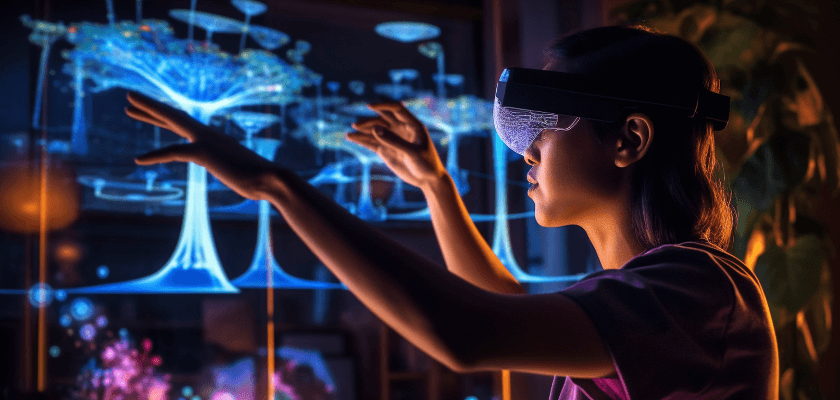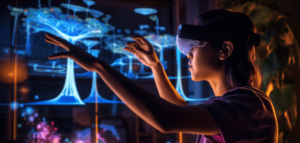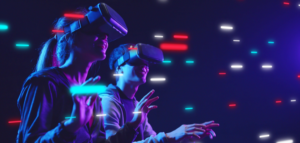
VR and AR Gamification for Immersive Customer Experiences
Imagine wearing special glasses that show you extra things in the real world, like information bubbles or cool 3D models. That’s augmented reality (AR)! It adds digital stuff onto what you see normally.
Virtual reality (VR) is like stepping into a whole new world created by computers. Imagine putting on a VR headset and finding yourself in a training session, playing games, or visiting distant locations without ever leaving your house. VR brings you adventures and experiences that you could only dream of in real life.
So, AR improves the real world, while VR creates a new one. As Multiplayer Agency, we’re here to guide you through all the details. Both these technologies are changing the way we learn, play, and even shop!
Turning Engagement into a Game: The Power of Gamification
Gamification involves intentionally applying design concepts and game dynamics in non-game settings. When adding components to routine tasks—such as points, badges, leaderboards, or challenges; it becomes clear why.
Using the power of play to improve customer engagement and marketing is the goal of gamification. Brands have the ability to enhance customer engagement and loyalty by integrating features that are essentially enjoyable and inspiring. Gamification transforms businesses and has the power to encourage desired actions, such as making purchases, experimenting with new goods, and recommending friends. It increases the fun and recall of brand interactions by creating a sense of competition and accomplishment.
The Role of VR and AR in Gamification
Immersive Experiences: Using AR and VR to add digital elements to the real world or create immersive virtual experiences makes things super cool and engaging. These technologies make interactions more lively and hold customers’ attention better than old-school methods.
Enhanced Engagement: VR and AR together with gamification have the potential to greatly increase customer engagement. These technologies boost unified customer experiences by incorporating game-like aspects like challenges, prizes, and interactive features.. This motivates customers to engage with the information more fully and stay interested longer.

Benefits of VR and AR Gamification for Customer Experiences
Gamification in VR and AR has many advantages for improving customer experiences. One major benefit is customization; these technologies may adjust to the unique preferences of each user, offering customized experiences that relate to the customer personally. Another key advantage is increased interaction; by generating immersive and interactive environments, VR and AR enable deeper engagement with goods and services. Because the immersive experiences allow for powerful emotions and create unforgettable moments, this level of involvement strengthens the deep connections between customers and brands. Furthermore, learning about items might become more informative and enlightening with the use of VR and AR, which could transform ordinary information into engaging and interactive experiences that are entertaining as well as instructional.
Interactive Product Demonstrations and Virtual Showrooms
When you point your phone at something or a marker, you can use AR to check out products in real-time. This helps you see how the products would look in your home before you buy them. On the other hand, VR lets you interact with virtual products in a super immersive way, making them seem totally real. This level of interaction shows off the value and usefulness of products way better than just regular photos or videos, which makes customers happier.
You can also explore virtual environments that look like real stores or create completely new experiences through virtual showrooms. These showrooms are especially helpful in industries where the space around the products is a big deal for making smart purchases, like real estate, furniture, and automotive.
Augmented Reality for In-Store Experiences
You can use AR to virtually try on clothes, accessories, and makeup, which makes shopping way more fun. With AR mirrors and mobile devices, you can see products superimposed on yourself, saving time and the hassle of trying on lots of different items. This tech isn’t just for fashion; it also works for furniture, accessories, and home renovations. You can visualize how products would look in your home, so you can shop online with confidence.
Virtual Reality Simulations
Travelers can now use VR simulations to check out travel destinations, accommodations, and tourist spots before making plans. This tech helps people make informed decisions and is a great marketing tool for travel agencies. With VR, you can virtually attend events like conferences and concerts. This gives you an experience of presence and helps event organizers reach a worldwide audience. Furthermore, the real estate sector uses virtual reality extensively for marketing. Virtual walkthroughs let potential buyers look at floor plans, change wall colors and furniture, and add personal touches. This virtual experience not only saves time but also attracts buyers from far away who are interested in properties.
Engaging Marketing Campaigns and Interactive Content
Companies can really draw people into their brand stories using AR and VR, turning them from passive viewers into active players and brand champions.
Gamification in Marketing
It’s great to see how brands are really focusing on creating engaging and interactive experiences for users. By using AR into their mobile apps and marketing efforts, they’re getting better in captivating their audience. Additionally, the use of virtual reality to immerse users in branded settings shows a real commitment to providing memorable and captivating experiences.
Interactive Storytelling
AR and VR technologies enable interactive storytelling, allowing consumers to experience brand narratives in a dynamic and personal way. Using digital content over the real world, brands can create augmented environments that lead customers through immersive narratives as they navigate physical spaces. Customers can explore at their own pace, making choices that shape the story and enhance their adventure.
Augmented Reality Filters and Lenses on Social Media Platforms
People can now have fun interacting with brands on social media using AR filters and lenses. These filters let users play with virtual objects, be in cool branded settings, or change how they look. Brands also use custom filters to get people to naturally share sponsored stuff with their friends and followers, like promoting events, new products, or getting the brand out there.
User-Generated Content and Community Engagement
User-generated content (UGC) is highly authentic and can enhance AR/VR campaigns by encouraging deeper consumer engagement. Users can create their own content using branded AR filters or VR environments and share it on social media, showcasing real people interacting with the brand in creative and personalized ways. Successful UGC campaigns can generate significant buzz and increase brand trustworthiness and relatability.
Enhancing Customer Service with VR
VR has the potential to improve customer service by enabling remote troubleshooting, which allows both parties to view and feel the same virtual environment, resulting in faster issue resolution. This high-tech method of customer service shows how much a brand values its customers.
The Impact of VR on Customer Experience
Recent studies reveal that when customers enjoy an amazing experience, they tend to spend more on products or services. VR lets brands create new experiences that can really make customers happy and loyal to the brand. As VR technology gets better and cheaper, businesses can keep adding new stuff to their VR experiences, giving customers even more fun and affordable experiences.
In the article “The Impact of VR/AR-Based Consumers’ Brand Experience on Consumer-Brand Relationships”, ResearchGate explains about how VR and AR technologies make brand experiences better and help strengthen relationships between consumers and brands. It identifies four types of VR and AR experiences; entertainment, aesthetic, educational, and real-escape, and finds that these experiences positively impact consumer satisfaction and purchase intentions. The study highlights that brand authenticity moderates the effect of these experiences, making consumers more likely to form positive relationships with brands when authenticity is perceived as high. By providing immersive and realistic interactions, VR and AR not only improve user engagement but also promote sustainable consumer behaviors by reducing the need for physical sampling and shopping, thus offering significant implications for sustainable marketing practices.
Real Case Examples
19 Crimes and Living Wine
19 Crimes Wine uses AR to engage customers by bringing the brand’s historical storylines to life. Users of the Living Wine Labels app may scan their wine labels to view animations of nineteenth-century inmates telling their stories. This enjoyable, interactive experience not only communicates the wine’s rich history, but also makes the selecting process interesting and unforgettable. The gamified aspect of unlocking new stories by scanning multiple bottles promotes repeat purchasing and social sharing.
This innovative strategy had a significant impact, resulting in over 5.5 million app downloads and a 40% increase in revenue since its launch. The success of 19 Crimes’ AR and gamification strategy expanded to other Treasury Wine Estates brands, increasing their popularity as well. This unique blend of history, technology, and gamification sets 19 Crimes apart in a crowded market, creating a memorable and enjoyable experience for wine lovers everywhere.
Puma The Black station
Puma is diving into virtual reality and immersive brand experiences with the launch of Black Station 2, a metaverse platform that bridges the digital and physical worlds. This innovative platform builds on the original Black Station, which debuted during New York Fashion Week last year. Black Station 2 offers users the chance to explore two distinct virtual worlds, Unkai and Unter, each showcasing new and exclusive phygital (physical + digital) footwear designs.

PUMA Pass NFT holders can purchase “Materializer” NFTsand Digital Collectible NFTs. Up to 4,000 of each type of NFT will be available for purchase. It also allows purchases via cryptocurrency and credit cards, making it accessible to a wider audience.
Black Station revives a concept from 20 years ago when it was a hub for PUMA’s most innovative designs. Now, it serves as a digital portal for exploration across fashion, sports, and heritage classics.
PUMA’s Black Station 2 exemplifies how brands can create engaging and futuristic shopping experiences through the metaverse. By blending virtual reality with physical products, PUMA not only enhances customer interaction but also marks its presence in the evolving Web3 and NFT spaces. This strategy provides PUMA as a progressive brand ready to adapt and define the future of retail.
Conclusion
AR and VR integration into marketing and customer experience strategies can greatly boost customer engagement, satisfaction, and loyalty. These immersive technologies enable new opportunities to communicate with customers, offer practical support, and create deeper connections with brands. As AR and VR become more accessible and affordable, their ability to redefine customer experiences and drive business success will only increase.




















